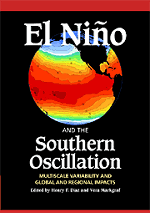Book contents
- Frontmatter
- Contents
- Contributors
- Acknowledgments
- Preface
- SECTION A Global and Regional Characteristics and Impacts of ENSO Variability
- 1 ENSO and Climatic Variability in the Past 150 Years
- 2 Understanding and Predicting Extratropical Teleconnections Related to ENSO
- 3 Global Modes of ENSO and Non-ENSO Sea Surface Temperature Variability and Their Associations with Climate
- 4 Multiscale Streamflow Variability Associated with El Niño/Southern Oscillation
- 5 El Niño/Southern Oscillation and the Seasonal Predictability of Tropical Cyclones
- 6 Climate and ENSO Variability Associated with Vector-Borne Diseases in Colombia
- SECTION B Long-Term Changes in ENSO: Historical, Paleoclimatic, and Theoretical Aspects
- Index
6 - Climate and ENSO Variability Associated with Vector-Borne Diseases in Colombia
from SECTION A - Global and Regional Characteristics and Impacts of ENSO Variability
Published online by Cambridge University Press: 04 August 2010
- Frontmatter
- Contents
- Contributors
- Acknowledgments
- Preface
- SECTION A Global and Regional Characteristics and Impacts of ENSO Variability
- 1 ENSO and Climatic Variability in the Past 150 Years
- 2 Understanding and Predicting Extratropical Teleconnections Related to ENSO
- 3 Global Modes of ENSO and Non-ENSO Sea Surface Temperature Variability and Their Associations with Climate
- 4 Multiscale Streamflow Variability Associated with El Niño/Southern Oscillation
- 5 El Niño/Southern Oscillation and the Seasonal Predictability of Tropical Cyclones
- 6 Climate and ENSO Variability Associated with Vector-Borne Diseases in Colombia
- SECTION B Long-Term Changes in ENSO: Historical, Paleoclimatic, and Theoretical Aspects
- Index
Summary
Abstract
Climatic factors are associated with the incidence of diverse vector-borne diseases (VBDs). Colombia, located in tropical South America, witnesses high precipitation rates and temperatures, varying with elevation over the Andes. We show how temperatures are linked to malaria incidence throughout the country, and we compare those results with those obtained via simple mathematical expressions that represent indices associated with malaria transmission as a function of temperature. Interannual climatic variability in tropical South America is strongly associated with El Niño/Southern Oscillation (ENSO). Most of the region, including Colombia, experiences prolonged dry periods and above normal air temperatures during El Niño, and generally opposite conditions during La Niña. Through correlation analysis, we show that during El Niño events there are outbreaks of malaria and dengue fever in Colombia. These outbreaks could be explained in terms of a decrease in precipitation and an increase in air temperature, which favor the ecological, biological, and entomological components of these diseases.
We illustrate the ability to predict malaria cases in Colombia by using an epidemiological model based on the concept of vectorial capacity (see Martens et al. 1997). This transmission potential model is driven with surface air temperatures derived from an atmospheric general circulation model (ECHAM3 model, Max Planck Institute for Meteorology) with a spatial resolution of about 300 km. The malarial model produces peaks in Plasmodium vivax vectorial capacity during El Niño years and an upward trend with time, in agreement with the Colombian malarial historical record.
- Type
- Chapter
- Information
- El Niño and the Southern OscillationMultiscale Variability and Global and Regional Impacts, pp. 183 - 204Publisher: Cambridge University PressPrint publication year: 2000
- 3
- Cited by

